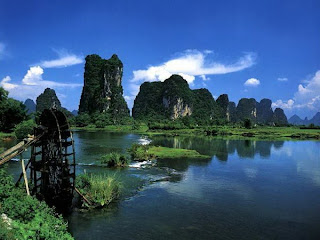Thursday, October 17, 2013
Tuesday, July 30, 2013
Dunhuang-Ancient in Ancient
Dunhuang-Ancient in Ancient
Known as Shazhou in ancient times, Dunhuang was served as a rest stop for traders as the gateway through which Buddhism, Islam and Christianity entered China.
Dunhuang is located at the western end of Hexi Corridor in Gansu Province in northwest of China. It is 2000 kilometers west of Beijing, right on the silk road that caravans would take to get from China to the Middle East.
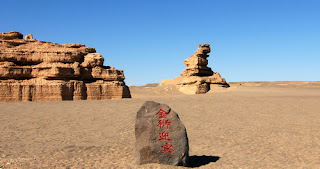 |
| Desert in Dunhuang |
It is a small oasis surrounded by high mountain, deserts and the Gobi Desert with Dang River as the city's water supply. The city boasts 241 places of historic interests, and many of them are world-famous for its long history, such as Mogao Grottoes, one of the greatest reminders of the silk trade in ancient time.
Other sites include the White Horse Pagoda, the Yangguan Pass and the Yumenguan Pass. These sights cannot rival in beauty with the caves, but it is quite some fun getting there through the desertlike landscape.
Dunhuang is the important ancient city in the Silk Road, and it is the hub of highway communication in the northwestern plateau in China.
Dunhuang means magnificent. In 11th century BC, some mineral nations lived here. In 111BC, the emperor of Han dynasty set up Jiuquan canton, and Dunhuang County was governed by it. The areas under Dunhuang's jurisdiction nowadays are the areas to the western and southern parts of Shule River in Gansu.
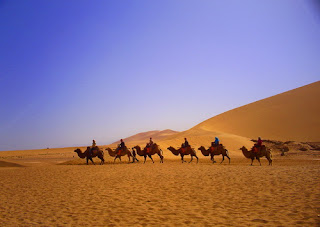 |
| Ride a Camel in the Desert |
From the two Hans to Southern and Northern Dynasties, Dunhuang was the thoroughfare between the middle part and the western part. The government of Dunhuang changed many times, but Dunhuang was always the capital of county, government office, town and province. And at that time, it was called Dunhuang or Shazhou.
In Song dynasty, it belonged to Western Hsia, and province was abolished. In Ming dynasty and Qing dynasty, Shazhou was changed into a province, later on; it was changed into Dunhuang province.
In Dunhuang, there are a lot of historical relics. Such as Mogao Caves, (it is called thousands of Buddha caves), it has 1500 years' history. It is in the important place in Chinese history.
Mogao Caves
Mogao Caves is a UNESCO World Heritage Site filled with exquisite Buddhist art and Manuscripts. Situated at a strategic point along the Silk Route, at the crossroads of trade as well as religious, cultural and intellectual influences, the 492 cells and cave sanctuaries in Mogao are famous for their statues and well paintings, spanning 1,000 years of Buddhist art.
The grottoes in the Mogao Caves are the world's largest and oldest treasure house of Buddhist art.
 |
| Mogao Caves |
It also known as the One-Thousand-Buddha Grottoes, are located on the eastern, rocky side of Singing Sand Mountain, near Dunhang City, Gansu Province. According to historical records, the carving of them was started in 366 AD and continued for about 1,000 years.
Now, there are 492 grottoes in existence, with some 45,000 square m of murals and 2,400-odd painted clay figures. The painted clay figures vary greatly in size, with the largest one being 33 m high and the smallest only 10 cm.
Painted clay sculptures and murals in the Mogao Grottoes have mainly Buddhist themes, but they also include human figures, reflecting various societies and cultures of different times. Besides, they also demonstrate painting styles of different times in layout, figure design, delineation and coloring, as well as the integration of Chinese and Western arts.
In 1900, a total of 4,500 valuable cultural relics dating from 256 AD to 1002 were found in the Buddhist Sutra Cave here, including silk paintings, embroidery and documents in rare languages such as ancient Tibetan and Sanskrit. This is regarded as one of the world's greatest Oriental cultural discoveries.
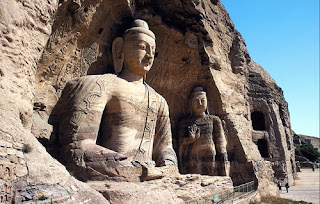 |
| Buddharupa |
The Mogao Grottoes show examples of various types of art, such as architecture, painting and statuary. By inheriting the artistic traditions of the central and western regions of China and absorbing the merits of ancient arts from India, Greece and Iran, ancient Chinese artists created Buddhist art works with strong local features. These art works are treasures of human civilization, providing valuable material for studies of the politics, economy, culture, religion, ethnic relations and foreign exchanges of China in olden times. Besides, there are also about 50,000 items of scriptures, documents, paintings and weavings written in several languages spanning the period from the Three Kingdoms Period to Northern Song Dynasty.
Grottoes: so far there are 492 grottoes, with murals and painted clay figures. There are meditation grottoes, Buddha hall grottoes, temple grottoes, vault-roofed grottoes and shadow grottoes. The largest grotto is 40 m high and 30 m wide, whereas the smallest is less than one foot high.
Painted Clay Figures: these are the main treasures of the Dunhuang Grottoes. The figures are in different forms, including round figures and relief figures. The tallest is 34.5 m high, while the smallest is only 2 cm. These painted clay figures show such a great variety of themes and subject matter, as well as advanced techniques, that the Mogao Grottoes are generally regarded as the world's leading museum of Buddhist painted clay figures.
 |
| Euphratica |
Murals: the murals in the Mogao Grottoes display Buddhist sutras, natural scenery, buildings, mountain and water paintings, flower patterns, flying Apsaras (Buddhist fairies) and ancient farming and production scenes. There are 1,045 murals extant, with a total area of 45,000 sq. m. They are artistic records of historical changes and customs and traditions from the 4th to the 18th centuries.
Excavated Articles: in 1900, about 50,000 cultural relics were found in a sanctum sealed behind the northern wall of Grotto No. 16. These articles included Buddhist sutras, documents, embroidery works and paintings from the 4th to the 12th centuries. Apart from ancient Chinese documents, there were also documents in other ancient languages, including Tibetan, Sanskrit and Uygur. The subjects of these documents include religion, literature, contracts, ledgers and official files. This discovery, which attracted world attention, is of great research value for supplementing and emending ancient Chinese documents.
--All in all, Dunhuang is like an arts palace and cultural house. There are Chinese ancient buildings, paintings and carvings. The ancient place of Yumenguan was the important pass of the northern part of the Silk Road.
Travel Tips for Dunhuang
Deserts, gobi, oasis, mountains and lakes are all shown in this area, and they enhance beauty of each other with fertile farmlands and abundant natural resources. The average height above the sea level in Dunhuang is 1,138 meters. It covers altogether 312,000 square kilometers.
The Danghe River, which is originated from the glacier in Qilian Mountains, runs through the whole oasis with endless stream. It is 390 kilometers in length with a runoff of 0.328 billion cubic meters per year. So it can irrigate 300,000mu fertile farmlands.
Climate: Dunhuang, being surrounded by high mountains, has an arid, continental climate. The annual average temperature is 9.3 °C (48.7 °F), but ranges from 24.7 °C (76.5 °F) in July to −9.3 °C (15 °F) in January. Dunhuang is extremely hot in summer and bitterly cold in winter. Precipitation occurs only in trace amounts and quickly evaporates.
Friday, July 26, 2013
40 Best Scenic Spots Recommended by CNN IX: Wuyi Mountain--------the Beauty of Confucianist
Wuyi Mountain
---- the Beauty of Confucianist
Wuyi Mountain tour is must-see attraction to travelers who want to explore Chinese culture. As the main mark of southeast of China and one heritage of UNESCO’s world culture heritages list, Wuyi Mountain is highly praised with its origin and development of Neo-Confucianism. Besides, Jiuqu River valley rafting is popular with tourists. If you want to appreciate the flat peaks and crystal river, rafting is your top choice in your China mountain tour to Wuyi. The 8 km drifting will let you have a great view of beautiful Wuyi Mountain.
General Introduction of Mountain Wuyi
Mt. Wuyi scenic spot, located in the southeast of Wuyi Mountain chain, south suburb of Wuyi city, Fujian province, is a famous Chinese tourism resort. It should’t be missed in your best China tour. Known as the First Famous Mountain of Fujian, the physiognomy of Wuyi Mountain belongs to Danxia landform. And Tianyou Peak, one peak of Wuyi mountains, is known as the first perilous peak in Wuyi. You won’t miss it in your China mountain tour.
 |
| Overlook View of Wuyi Mountain |
Moreover, Wuyi mountain is a historical and cultural famous mountain, a must place to explore Chinese mountain culture in your China mountain tour. Early in the Neolithic Period, the ancient Yue people multiplied here. And the famous “Jiahou Ship” and “Hongqiao Plate” on the cliffs are hanging coffins left by ancient Yue people. In western Han dynasty, Emperor Wu of Western Han once sent an emissary to Wuyi Mountain to sacrifice the Wuyi god. Then in Tang dynasty, Emperor Xuanzong of Tang issued a bunch of famous mountains and rivers including Wuyi mountains and also ordered that mountain forests should be protected and cutting trees should not be allowed. Actually, Wuyi mountain is always a famous mountain of Buddhism, Taoism and Confucianism since Qin and Han dynasties. There are many relics of Taoism temples, and nunneries. Wuyi mountain was once a place where Confucianists and scholars gave lectures. Taking a China mountain tour to Wuyi is worthwhile.
When you take a Wuyi Mountain tour, you maybe want to know the attractions of Wuyi mountains. So I am pleased to show you that. The famous attractions of Wuyi mountain chain are included Mt. Wuyi, Mt. Huanggang, Jiuqu River, Wuyi Water Curtain Cave, Wuyi Taoyuan Cave, National Forest Park, Qingzhou Rafting, Wuyi Palace, Wuyi Grand Canyon, Mt. Wuyi Longjing and Tianyou Peak. All of them are worth to be toured in your China tour to Wuyi.
When to take a China cultural tour to Wuyi , some information about the local climate is a must thing to you.The four seasons in Wuyi mountains are distinctive because Wuyi mountain chain is located in the subtropical zone. Overlaps of mountains, most of which are higher than 1800 meters, are formed a natural protective screen. It can stop or weaken the north cold air invasion. And the characteristics of Wuyi climate are abundant rainfall, high humidity, long moist weather and significant vertical change. Above all, the annual average temperate is 17.6 degree and annual average precipitation is 1864mm. And it is available to take a Wuyi Mountain tour in every season. Though it is cold in winter, the beauty of Wuyi also get a special flavor in your best China tour to Wuyi. Though the temperate of summer is relatively high, it is also fantastic to take a China tour to Wuyi because everything is growing flourishingly and the natural scenery of Wuyi is the most attractive at that time.
Local Species in Wuyi Mountain Tour
I am happy to introduce some local species to your guys when you take a Wuyi Mountain tour. Wuyi Rock Tea, also known as Da Hong Pao Tea, produced in the famous mountain Wuyi, is the masterwork of Chinese oolong tea with the scent of green tea and lusciousness of black tea, one
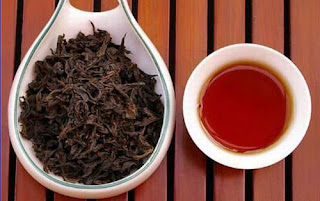 |
| Da Hong Pao Tea |
Tasty Feast in Wuyi Mountain Tour
Snacks is must in every China tour without exception of Wuyi mountain tour. There are variety of Wuyi snacks, such as Zixi Noodles, Smoked Goose, Lean Meat Soup, Qingming Guo, Zhuzi Xiao Mother Cake, Huma Rice, etc. You can find them easily in the Wuyi tourism district. Among them, Zhuzi Xiao Mother Cake is created by the famous Confucianist Zhuxi in south Song Dynasty.
Besides the above famous local snacks for your China tour to Wuyi, there are many seasonal snacks in Wuyi mountain region, such as Frozen Lychees. Frozen lychees, made of wild lychees,
 |
| Rafting on the River |
Transportation of Wuyi Mountain Tour
It is convenient to go to Wuyi scenic spot from Wuyi city in China tour to Wuyi. There are tourism express buses along the way to Wuyi mountain.
As for airplane transportation, Wuyi airport has been opened 10 airlines to Fuzhou, Xiamen, Jinjiang, Beijing, Shanghai, Wuhan, Guangzhou, Shenzhen, Zhuhai and Changzhou.
As for railway transportation, there is one air-conditional fast train to Wuyi from Fuzhou, Xiamen and Quanzhou everyday. Moreover, there are two trains to Wuyi from shanghai daily. Is is more convenient for people to take a fantastic China Wuyi tour.
Ticket Tips in Wuyi Mountain Tour
Wuyi pass:
Wuyi one-day tour: RMB 210(including entrance ticket RMB 140 and sightseeing transfer fee RMB 70)
Wuyi two-day tour: RMB 235(including entrance ticket RMB 150 and sightseeing transfer fee RMB 85)
Wuyi Three-day tour:RMB 255(including entrance ticket RMB 160 and sightseeing transfer fee RMB 95)
Wuyi Jiuqu Rafting ticket: RMB 100
Thursday, July 18, 2013
White Horse Temple
White Horse Temple
The White Horse Temple enjoys the reputation of the No.1 Ancient Temple of China. It lies on the south of Mangshan Mountain, and faces the Luohe River in the south. The construction of the temple started in the 11th year (68) during the Yongping reign of Emperor Mingdi in the Eastern Han Dynasty (25-220). The White Horse Temple has a history of over 1900 years. It is the first temple built since Buddhism spread to China in the Han Dynasty (206BC-220AD).
 |
| The Whole View if White Horse Temple |
According to historical records, Emperor Mingdi of the Eastern Han Dynasty dreamed of a golden man flying above the courtyard. After he woke up, the emperor sent Cai Yin and Qin Jing as envoys to western regions to invite Buddha and learn Buddhism. The two envoys underwent much hardship and met two eminent Indian dignitaries She Moteng and Zhu Falan on the way.
Cai Yin and Qin Jing came back to Luoyang City with the two monks, and a white horse carrying the sutras. Emperor Mingdi ordered the construction of the temple to the north of the imperial road outside the Xiyong Gate of Luoyang City. The White Horse Temple, built after the style of Indian temples, was the place for She Moteng and Zhu Falan to translate Buddhist sutras and write sermons. In order to memorize the white horse for its carrying back of the sutras, the temple was named the White Horse Temple.
 |
| White Horse Temple |
The White Horse Temple has undergone many repairs and renovations in all previous dynasties. The present appearance is much different from its original one. What we see today was restored during the Ming Dynasty (1368-1644) and the Qing Dynasty (1644-1911), with an area of 34,000 square meters.
Facing south, the main buildings of the temple stand on or along the central axis, including the Temple Gate, the Heavenly King Hall, the Great Buddha Hall, the Main Hall, the Jieyin Hall, and the Pilu Pavilion, etc. Beside those main buildings are the Reception Chamber, the Cloud-water Chamber, the Ancestors Chamber, the Guests Chamber, the Buddhist Chamber, and the Abbot Courtyard and so on. The huge White Horse Temple has over 100 rooms.
Places to See
Hall of Heavenly Kings
This hall was originally built in the Yuan Dynasty. In the middle of the hall sits a laughing Buddha - Maitreya. It is said that the Buddha was once incarnated as a beggar monk with a purse, which actually contained all the treasures of the world. The shrine is made of wood with over 50 vivid dragons carved into it and is truly a remarkable example of Qing Dynasty (1644-1911) culture. On either side of Maitreya stand the four majestic 'Celestial Kings'. Each holds a different weapon and all four are clay sculptures moulded during the Qing Dynasty.
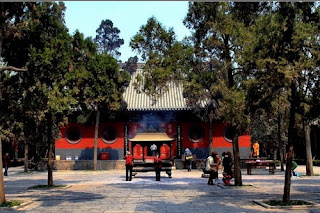 |
| Hall of Heavenly Kings |
Hall of the Great Buddha
This hall boasts the most spectacular architecture in the whole temple. The roof is covered with exquisite pantiles; the upturned eaves and the bracket system reflect the architectural style of the Ming Dynasty (1368-1644). A statue of the Buddhist patriarch Sakyamuni stands in the middle of the hall for people to make offerings to. He is flanked by two of his disciples - Kasyapa and Ananda. The one with sutra in his hands is the Bodhisattva of Wisdom - Manjusri. The other is the Bodhisattva of Universal Benevolence - Samantabhadra. All of these statues provide vivid portraits with smooth lines and demonstrate a high level of craftsmanship of the Ming Dynasty.
Hall of Guidance
This hall is where the Amitabha Buddha is worshipped and is the smallest in the temple. This Buddha is in charge of the Western Paradise. On his right and left are the Bodhisattva of
 |
| Hall of the Great Buddha |
Hall of Mahavira
This is the most magnificently decorated hall in the temple. The roof is carved with colorful lotus patterns and the walls are hung with thousands of the wooden statues of Buddhist figures. In the centre of the hall stands a two-storey Buddhist shrine exquisitely carved with birds in flight and giant winding dragons which lend the shrine its awesome appearance. The three saints Sakyamuni, Amitabha and the Buddha of Medicine look jovial with the eighteen arhats standing around and all are made from silk and hemp. Each one weighs only three to five kilograms (about seven to eleven pounds). The colors on these statues are still as fresh today as when they were first produced during the Yuan Dynasty. They are priceless treasures of the nation.
The Cool and Clear Terrace
 |
| The Exterior of Hall of Mahavira |
This is a high brick terrace built in the yard at the rear of the temple where the sutras and Buddhist figures, brought back by the white horse, were once stored. It is also the place where the two Indian monks translated the sutras during the Eastern Han Dynasty. The terrace was the first place at which Buddhist sutras were translated in China and for this reason, it is one of the most famous locations in the temple.
Outside the temple, there is a tiered brick pagoda named Qiyun Pagoda, which is actually the oldest of China's ancient pagodas. It is the earliest example of ancient architecture in Luoyang and also one of the most precious Jin Dynasty (1115-1234) structures in the Central Plains of China. Standing south of the pagoda and clapping your hands, you will discover that the echoes you hear sound quite similar to the noise of frogs croaking. This perplexing phenomenon attracts many curious tourists every day.
As the first Buddhist temple in China, the White Horse Temple plays a significant role in the history of Chinese Buddhism and China's international cultural exchanges. After the founding of the People's Republic of China, the People's Government paid much attention to the temple and thoroughly restored it several times from 1952 to 1973. It has become an attraction to domestic and foreign tourists.
Monday, July 15, 2013
40 Best Scenic Spots Recommended by CNN VIII: Yugang Grottoes, A Treasure of World Grottoes
Buddhism, one of the most popular religions in China. You can find a lot of Buddhist architectures like temple, Grottoes which built many years ago. Yugang Grottoes, will be talked about in the article, is one of the four major grottoes in China. Explore it when you take a China tour to Datong.
Chapter Eight
Yungang Grottoes, A Treasure of World Grottoes
Are you interesting in culture heritages in China? Are you curious about Chinese Buddha? If one of the answer is YES, you should not miss this article.
Background of Yungang Grottoes
Talking about Yungang Grottoes, the first thing you should know is the background. The grottoes
were built in Northern Wei Dynasty around A.D.460 for emperors to pray for the country prosperity and to release souls from suffering. Although at that time, the Buddhism was not as prosperous as it in Tang Dynasty, the governors hoped the grottoes of Buddhism can consolidate their power. It took years to finish this gorgeous heritage and it witness the prosperity and decline of Chinese grottoes.
 |
| Whole View of Yugang Grottoes |
Introduction of Yungang Grottoes
Composed by 45 grottoes, yungang grottoes is one of the four greatest grottoes in China and is a UNESCO Culture Heritage (Grottoes) together with Mogao Grottoes, Longmen Grottoes and Dazu Carving in China. It is also the essence of Chinese grottoes in 5th century.
Facing the 45 grottoes, you may be confused and want to know which one is the best one. Among the 45 grottoes, the first 20 are the best ones for tourists to this scenic spot. The
content of grottoes, the carving skill and painting are the top ones comparing with the rest. yungang Grottoes are the beginning of stylish transformation of grotto art into Chinese. By seeing the first 20 grottoes, you will learn track of how Indian and Middle Asia Buddhism art were changed into the Chinese one. Besides, the grottoes will show you three periods’ artistic style of China --exotic in Early Northern Wei, luxury in Middle time and exquisite in late Northern Wei. If you are interesting in Chinese culture of Northern Wei, yungang Grottoes area good reference.
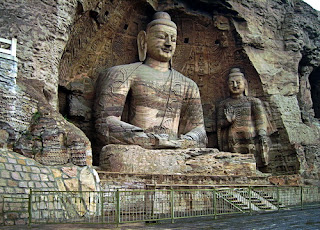 |
| The 20th Grottoes |
Recommended Grottoes in Yungang Grottoes
Although the first 20 grottoes are the best ones for traveling in yungang Grottoes, there are some most popular ones among the first 20 grottoes.
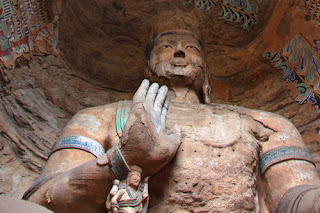 |
| The Fifth Grottoes |
The 20th grottoes: Carved three Buddhas, it is the representative of yungang Grottoes Carving Art
The 16th grottoes: There are thousands of Buddhas carved with shrine. The carvings are beautiful.
The 15th grottoes: Called the Wanfo Grotto, here you will see ten thousand buddha carving here.
Being a relic built in 1500 years ago, yungang Grottoes are not as charm as before. With time goes by and people’s damage, the color of the carvings has faded and many statues in the grottoes are broken. Chinese government has taken actions to restore the broken ones but it is a huge project. If you travel to yungang Grottoes, please following the guide.
Thursday, July 11, 2013
40 Best Scenic Spots Recommended by CNN VII: Landmark of Qingdao, Zhan Qiao Pier
It's Summer in China Now and it's very hot in many cities. If you travel in China now, I recommend Qingdao as a summer resort to you. When you visit Qingdao, you will see a famous bridge by the sea. It is called Zhan Qiao, which is a symbol of Qingdao.
Have you been to Qingdao? Have you known something about Qingdao Zhan Qiao Pier?
Although Zhan Qiao pier is not the top attractions in China, its history background make it an important part of Qingdao city and a must-see attraction during your China tour to Qingdao with the famous Tsingtao Brewery Factory and Catholic Church.
Milestone: Landmark of Qingdao City, the first scenic spot since Qingdao government began to operate tourism and one of the Qingdao Top 10 scenic spots.
Location: At the southern shore of Qingdao off Zhongshan Road.
Originally, Qingdao Zhan Qiao pier was built by government to transfer the military resources in Qing Dynasty. It was 200 meters long and 10 meters wide. In 1931, it had been reconstructed and the length of it had been prolonged to 440 meters . Besides, a pavilion was added on the pier called Huilan Ge (回澜阁). From 1998 to 1999, local government renovated Zhan Qiao that makes it more beautiful than before. To people in Qingdao, they think Zhan Qiao Pier is the symbol of our homeland.
In the vicinity of Zhan Qiao Pier is the small Qingdao Island (Xiao Qingdao), the Qingdao Navy Museum, and many neighborhoods featuring German colonial architecture. The coastline lights up at night with spotlights on nearby buildings and several neon billboards.
Visiting Qingdao, you should not miss Zhan Qiao pier. Being the witness of Qingdao’s development, it will tell you more about this city. Knowing a city should learn the history and culture of this city. Zhan Qiao pier is a channel for you to learn Qingdao.
Chapter Seven
Landmark of Qingdao, Zhan Qiao Pier
Have you been to Qingdao? Have you known something about Qingdao Zhan Qiao Pier?
Although Zhan Qiao pier is not the top attractions in China, its history background make it an important part of Qingdao city and a must-see attraction during your China tour to Qingdao with the famous Tsingtao Brewery Factory and Catholic Church.
 |
| Overlook View of Qingdao Zhan Qiao |
Milestone: Landmark of Qingdao City, the first scenic spot since Qingdao government began to operate tourism and one of the Qingdao Top 10 scenic spots.
Location: At the southern shore of Qingdao off Zhongshan Road.
Originally, Qingdao Zhan Qiao pier was built by government to transfer the military resources in Qing Dynasty. It was 200 meters long and 10 meters wide. In 1931, it had been reconstructed and the length of it had been prolonged to 440 meters . Besides, a pavilion was added on the pier called Huilan Ge (回澜阁). From 1998 to 1999, local government renovated Zhan Qiao that makes it more beautiful than before. To people in Qingdao, they think Zhan Qiao Pier is the symbol of our homeland.
 |
| Back to Lan House |
In the vicinity of Zhan Qiao Pier is the small Qingdao Island (Xiao Qingdao), the Qingdao Navy Museum, and many neighborhoods featuring German colonial architecture. The coastline lights up at night with spotlights on nearby buildings and several neon billboards.
Visiting Qingdao, you should not miss Zhan Qiao pier. Being the witness of Qingdao’s development, it will tell you more about this city. Knowing a city should learn the history and culture of this city. Zhan Qiao pier is a channel for you to learn Qingdao.
Friday, July 5, 2013
40 Best Scenic Spots Recommended by CNN VI: Huangguoshu Waterfalls
Do you remember the astounding waterfalls in the film Up? It's very very beautiful, isn't it? There also is a very splendid waterfall in China, in the article, follow me to discover the amazing scenery in Guizhou.
Huangguoshu waterfalls, located in the Zhenning autonomous county, Anshun, Guizhou province , is the biggest waterfall group in the world. You won’t miss it in your China Guiyang tour. There are 18 cascades along Dabang River with Huangguoshu waterfall as the core, formed the gorgeous characteristics of grandness, strangeness, precipitousness and excellence. It is worthy of taking a China tour there. And Huangguoshu waterfall group was list in the Guinness World of Records as the biggest waterfall group in the world in 1999. Moreover, Huangguoshu waterfall is
the essence of the waterfall group. It is the only waterfall in the world that can be appreciated from six direction such as up, down, forward, backward, left and right and there is a natural water curtain cave behind the waterfall, so Huangguoshu waterfall could be touched, watched both inside and outside from the hole. China Huangguoshu tour will make your trip unforgettable.
If you take a China tour to Huangguoshu, you should know that the main scenic spots in Huangguoshu waterfalls are Huangguoshu waterfall scenic spot, Shitou Zhai scenic spot, Tianxing Bridge scenic spot, Dishui Tan waterfall scenic spot, Baling river valley, Three Kingdoms ancient road scenic spot, Doupo Tang scenic spot and Langguan scenic spot.
Besides, there are two travel line suggested to your China Huangguoshu tour. The first one is Huangguoshu waterfalls-----Tianxing Bridge------Doupo Tang-----Tianlong Tunbao one day tour. The other is Huangguoshu waterfalls-----Tianxing Bridge------Doupo Tang------Longgong one day tour.
In summer, the temperate is around 30 degree in Huangguoshu waterfall scenic spot with a relatively strong solar radiation. You should prepare some shading coats in your Huangguoshu
tour. And summer is the time when Huangguoshu waterfalls own abundant water volume so many tourism channels are slippery. You need prepare your raincoat in advance. Note that when caught by a thunderstorm in your China Huangguoshu tour, remember not to use an umbrella. Besides, in spring and autumn, the rainfall in scenic spot is abundant and the weather is very cold, you should take two more warm clothes before your Huangguoshu tour and some common medicine as well.
Some local species should’t be missed in your China Guiyang tour. Named after Huangguoshu waterfall, Guizhou cigarette factory produced Huangguoshu cigarette. And a kind of local fruit named Huangguo, it is famous around travelers who take a China tour to Guiyang Huangguoshu. The fruit of Huangguo is golden yellow and tastes sweet and little sour with enough moisture. You may have a taste in your China tour. Moreover, the wax printing and embroidery of Miao community are also very famous. In those many Miao embroidery works, the most famous works are girls’ splendid attires and flower back fans used in the Jump Flower Festival. It is worthy of taking some Miao embroidery works home in your Huangguoshu tour.
Food is the paramount necessity of the people. It won’t be missed in your Huangguoshu tour. Local Anshun dishes are Babao baby lampreys, roast pig, gastrodia elata yuanyang pigeon, cold mix houttuynia, houttuynia fried pork, etc. And local snacks are Anshun beef noodles, Zhenning bobo sugar and Zhenning huajiang dog meat.
1. Air Transportation
The fastest way to take a China Huangguoshu tour is by air. Huangguoshu airport has been opened through several cities such as to Guangzhou, Qingdao, Kunming, Shenyang, Chongqing and Beijing since built in 2004. And it is located in the east suburb of Anshun city not very far to Huanguoshu waterfalls.
2. Railway Transportation
The railway transportation in Anshun is relatively developed. It may be a good choice to take a China tour to Huangguoshu by train. The railway from Guiyang to Kunming passes throughout the whole city and Anshun is connected with other provinces by Guiyang-Anshun, Sichuan-Chongqing, Chongqing-Guangxi and other railways. Moreover, the tourist-dedicated train
“Huangguoshu” setting back and forth between Guiyang and Anshun everyday enhanced the inner provincial tourist transportation. Besides, the railway station of Anshun is located in the end of Nanhua Road, easy to get to. There are buses directly to Huangguoshu scenic spots with a transfer fee of RMB 8.
3.Highway Transportation
Huangguoshu scenic spot is located in the southwest of Anshun, 45km away from Anshun city and 137km away from Guiyang. There are many comfortable and quick highways to Huangguoshu waterfalls. It takes only around 2 hours from Guiyang to Huangguoshu by coach.
The ticket including Huangguoshu waterfall, Tianxing Bridge and Doupo Tang
High season(March to October): RMB 180 per person
Low season(November to February) RMB 160 per person
Huangguoshu Stone Museum: RMB 70 per person
Huangguoshu travel package(including scenic ticket, Stone museum, and sightseeing car): RMB 300 per person
Scenic spot escalator: round trip RMB 50 per person; single trip RMB 30 per person
Scenic environment car: RMB 50 per person:
Tianxing Bridge cable car: RMB 10per person
Shitou Zhai scenic spot: RMB 40 per person
Shenlong Cave: RMB 70 per person
Huangguoshu drift: RMB 160 per person
Chapter Six
Huangguoshu Waterfalls
Brief Introduction of Huangguoshu Waterfalls
Huangguoshu waterfalls, located in the Zhenning autonomous county, Anshun, Guizhou province , is the biggest waterfall group in the world. You won’t miss it in your China Guiyang tour. There are 18 cascades along Dabang River with Huangguoshu waterfall as the core, formed the gorgeous characteristics of grandness, strangeness, precipitousness and excellence. It is worthy of taking a China tour there. And Huangguoshu waterfall group was list in the Guinness World of Records as the biggest waterfall group in the world in 1999. Moreover, Huangguoshu waterfall is
 |
| Huangguoshu Waterfall |
If you take a China tour to Huangguoshu, you should know that the main scenic spots in Huangguoshu waterfalls are Huangguoshu waterfall scenic spot, Shitou Zhai scenic spot, Tianxing Bridge scenic spot, Dishui Tan waterfall scenic spot, Baling river valley, Three Kingdoms ancient road scenic spot, Doupo Tang scenic spot and Langguan scenic spot.
Besides, there are two travel line suggested to your China Huangguoshu tour. The first one is Huangguoshu waterfalls-----Tianxing Bridge------Doupo Tang-----Tianlong Tunbao one day tour. The other is Huangguoshu waterfalls-----Tianxing Bridge------Doupo Tang------Longgong one day tour.
Information of Scenic Climate
In summer, the temperate is around 30 degree in Huangguoshu waterfall scenic spot with a relatively strong solar radiation. You should prepare some shading coats in your Huangguoshu
 |
| Close Shot of Huangguoshu Waterfall |
Local Species
Some local species should’t be missed in your China Guiyang tour. Named after Huangguoshu waterfall, Guizhou cigarette factory produced Huangguoshu cigarette. And a kind of local fruit named Huangguo, it is famous around travelers who take a China tour to Guiyang Huangguoshu. The fruit of Huangguo is golden yellow and tastes sweet and little sour with enough moisture. You may have a taste in your China tour. Moreover, the wax printing and embroidery of Miao community are also very famous. In those many Miao embroidery works, the most famous works are girls’ splendid attires and flower back fans used in the Jump Flower Festival. It is worthy of taking some Miao embroidery works home in your Huangguoshu tour.
 |
| Sculpture |
Tasty feast in Huangguoshu waterfalls
Food is the paramount necessity of the people. It won’t be missed in your Huangguoshu tour. Local Anshun dishes are Babao baby lampreys, roast pig, gastrodia elata yuanyang pigeon, cold mix houttuynia, houttuynia fried pork, etc. And local snacks are Anshun beef noodles, Zhenning bobo sugar and Zhenning huajiang dog meat.
The Transportation of Huangguoshu Waterfalls
1. Air Transportation
The fastest way to take a China Huangguoshu tour is by air. Huangguoshu airport has been opened through several cities such as to Guangzhou, Qingdao, Kunming, Shenyang, Chongqing and Beijing since built in 2004. And it is located in the east suburb of Anshun city not very far to Huanguoshu waterfalls.
2. Railway Transportation
The railway transportation in Anshun is relatively developed. It may be a good choice to take a China tour to Huangguoshu by train. The railway from Guiyang to Kunming passes throughout the whole city and Anshun is connected with other provinces by Guiyang-Anshun, Sichuan-Chongqing, Chongqing-Guangxi and other railways. Moreover, the tourist-dedicated train
 |
| Tourists are Taking Photo of Huangguoshu Waterfall |
3.Highway Transportation
Huangguoshu scenic spot is located in the southwest of Anshun, 45km away from Anshun city and 137km away from Guiyang. There are many comfortable and quick highways to Huangguoshu waterfalls. It takes only around 2 hours from Guiyang to Huangguoshu by coach.
Ticket Information of Huangguoshu waterfalls
The ticket including Huangguoshu waterfall, Tianxing Bridge and Doupo Tang
High season(March to October): RMB 180 per person
Low season(November to February) RMB 160 per person
Huangguoshu Stone Museum: RMB 70 per person
Huangguoshu travel package(including scenic ticket, Stone museum, and sightseeing car): RMB 300 per person
Scenic spot escalator: round trip RMB 50 per person; single trip RMB 30 per person
Scenic environment car: RMB 50 per person:
Tianxing Bridge cable car: RMB 10per person
Shitou Zhai scenic spot: RMB 40 per person
Shenlong Cave: RMB 70 per person
Huangguoshu drift: RMB 160 per person
Subscribe to:
Comments (Atom)
